The 12-speed XTR M9100 groupset is Shimano’s longest-standing 12-speed mountain bike groupset, first launched in mid-2018.
It debuted the brand’s all-new Micro Spline freehub technology, Shimano’s solution to squeezing 12 cassette sprockets into the same space as a traditional freehub body.
Headlining the XTR M9100 groupset is a rich assortment of luxury materials, including a carbon fibre derailleur cage and titanium cassette sprockets, plus plenty of attention to detail in a bid to improve performance and reduce weight.
XT M9100 groupset headline figures:
- Total weight (including 170mm cranks with 30t chainring, rear derailleur, 116-link chain, 10-51t cassette and shifter): 1,543g
- Total price (including 170mm cranks with 30t chainring, rear derailleur, 116-link chain, 10-51t cassette and shifter): £1,125.94 / $1,469.94 / AU$2,134
This range-topping groupset is ideal for people looking to take their bike to the next level in terms of looks, weight and price. Although it does have some faults, it isn’t as expensive as SRAM’s headlining XX1 Eagle AXS groupset, making it an attractive prospect for high-performance addicts.
Read our other groupset and drivetrain reviews:
Shimano XTR M9100 groupset details and specifications
The details of the XTR M9100 groupset are well detailed on BikeRadar, but I am going to cover top-line information and specs before diving into how it performs.
Shimano XTR FC-M9120-1 crankset with 30t chainring specifications
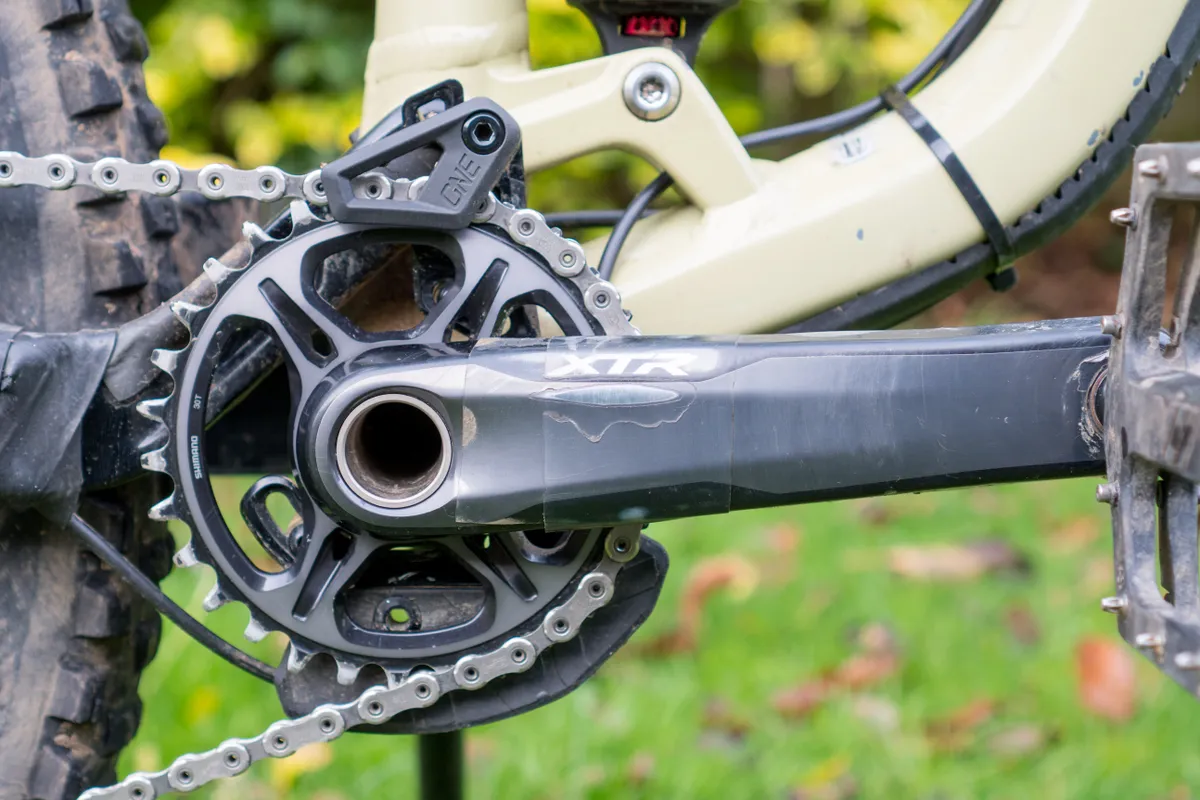
The crankset’s Hollowtech II technology means the pedal cranks have a hollow construction, which Shimano claims blends stiffness, strength and weight. The bottom bracket axle is integrated into the driveside crank arm, further improving stiffness and reducing weight compared to designs where the cranks and bottom bracket axle are separate pieces.
They have a 24mm-diameter axle, the same as the rest of Shimano’s Hollowtech II cranks, and will work with all Shimano’s outboard Hollowtech II bottom brackets.
Available in 165mm, 170mm and 175mm lengths for a host of Q-factors and chain lines, plus 1x and 2x setups, there should be an XTR crank compatible with most bikes.
Its chainring uses Hyperglide+ and Dynamic Chain Engagement+ tech, where its teeth profiles are designed to improve chain retention and work with Hyperglide+ chains to decrease wear and vibrations, improving the way the system pedals. The XTR SM-CRM95 chainring is available in 30-38t sizes in two-teeth jumps.
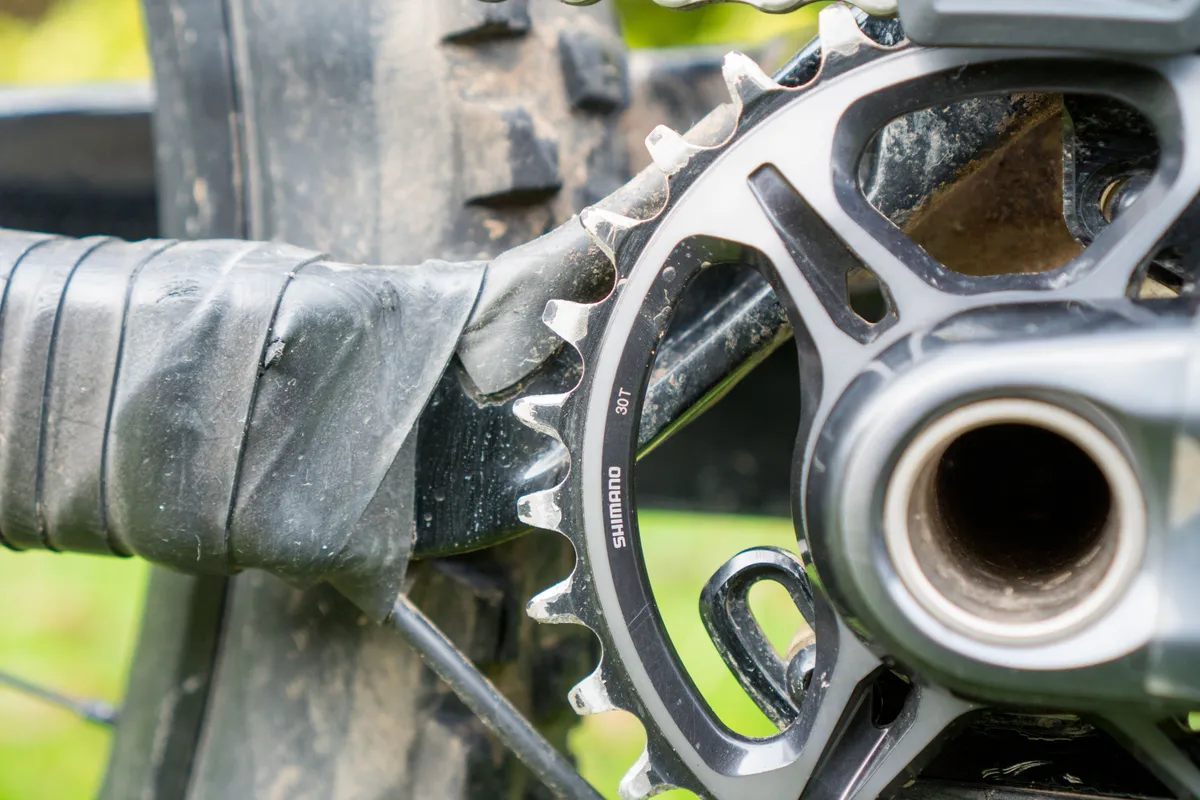
Notably, Shimano chainrings are designed to be used exclusively with Shimano chains.
The XTR FC-M9120-1 crankset (170mm arms without chainring) weighed 479g on my scales. The 30t XTR SM-CRM95 chainring weighed 68g, and a 32t version of the same ring weighed 72g.
Shimano XTR SL-M9100-R shifter specifications
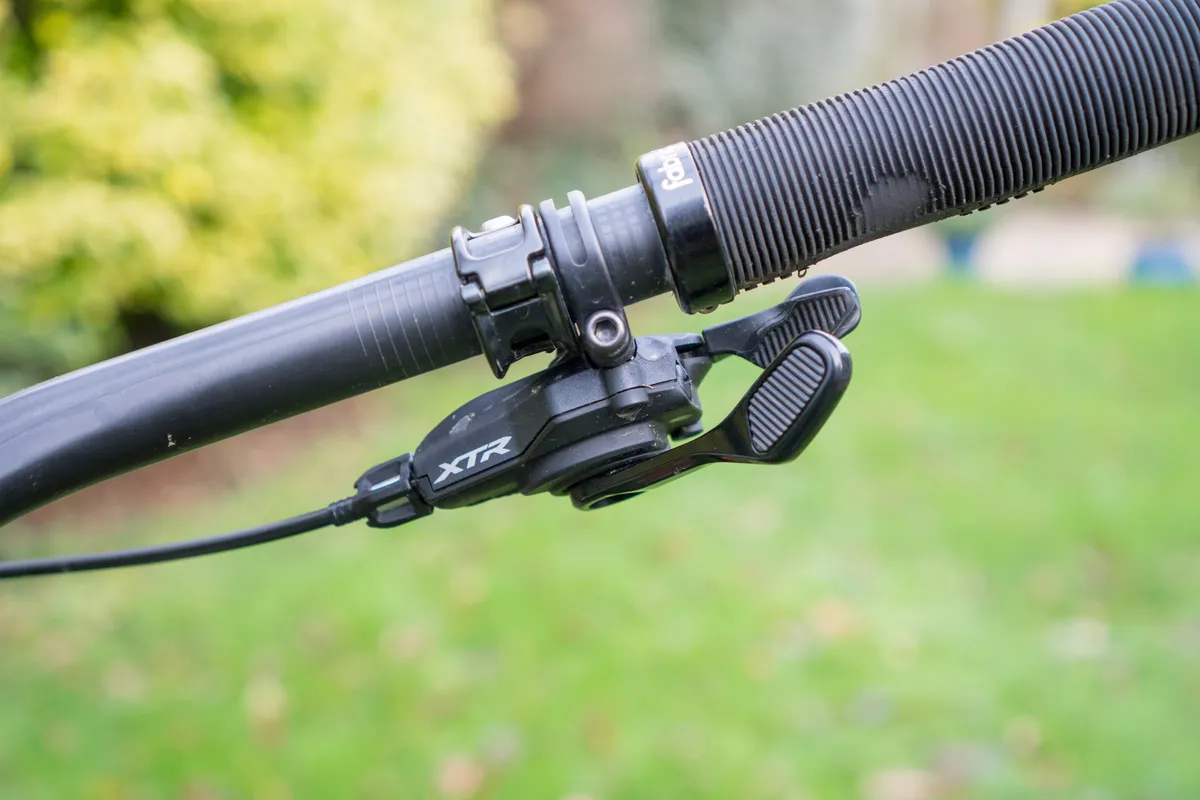
Sharing most of its technology with the XT M8100 shifter, including Multi-Release, 2-Way Release, Instant Release and Rapidfire plus, it is designed to improve shifting speed and give riders the ability to shift more than one gear at once, both up and down the cassette.
Although the XTR shifter isn’t technologically different from the XT version, it is claimed to have a lighter shifting force, and has four bearings instead of two in its mechanism. Finally, the supplied inner gear cable is polymer coated, which means it has a layer of factory grease applied.
The XTR SL-M9100-R shifter with band clamp and factory-supplied inner cable weighed 130g on my scales.
Shimano XTR RD-M9100-SGS rear derailleur specifications
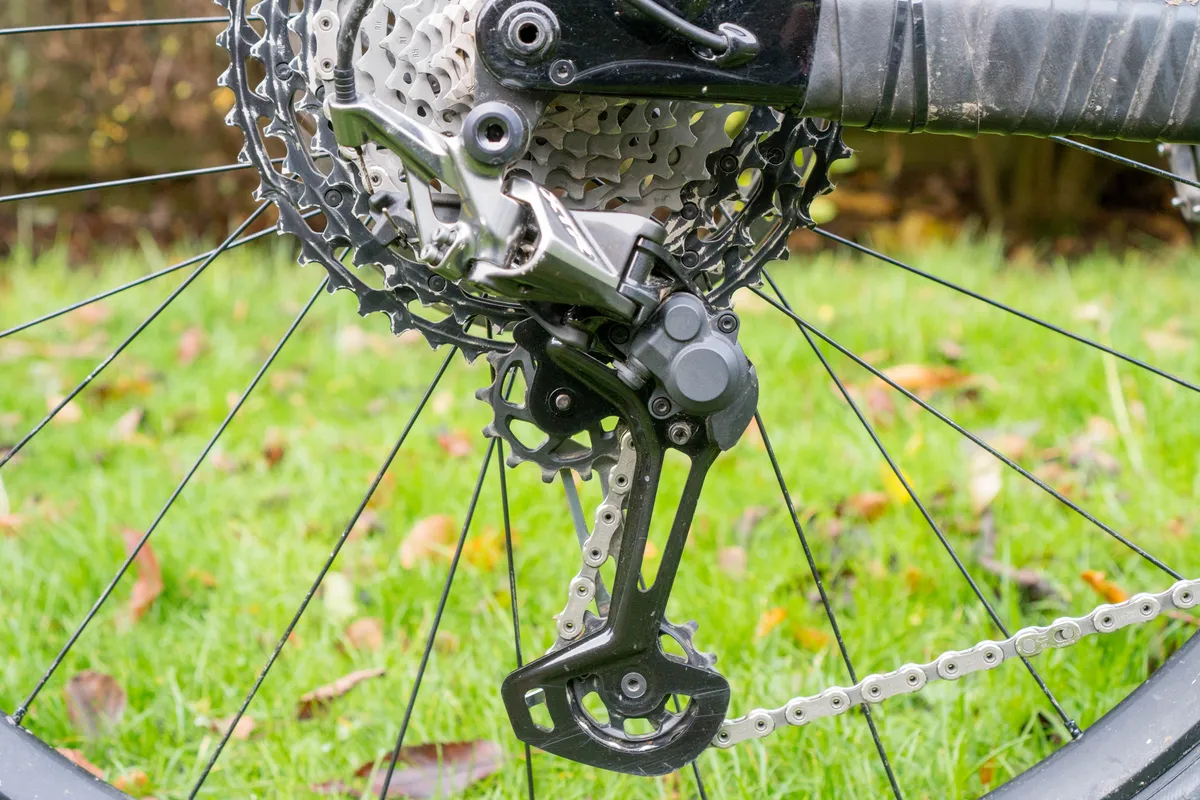
With a Shadow RD+ low-profile design, the XTR derailleur looks like its 12-speed stablemates. It also shares a lot of its technology with the XT derailleur, including 13t jockey wheels running on sealed bearings, a bumper on the top edge of the cage, and the on/off tension-adjustable clutch. Like the other derailleurs in Shimano’s range, it has been designed to be used with Hyperglide+ chains.
The outer plate of its cage is made from carbon fibre, while the inner plate is aluminium, and its parallelogram and overall design mean it is made from the least material possible. It also has eight (rather than seven on the XT version) fluoric-coated link bushings to improve shifting.
The XTR RD-M9100-SGS rear derailleur weighed 243g on my scales.
Shimano XTR CS-M9100 (10-51t) cassette and Shimano XTR CN-M9100 (116-link) chain specifications
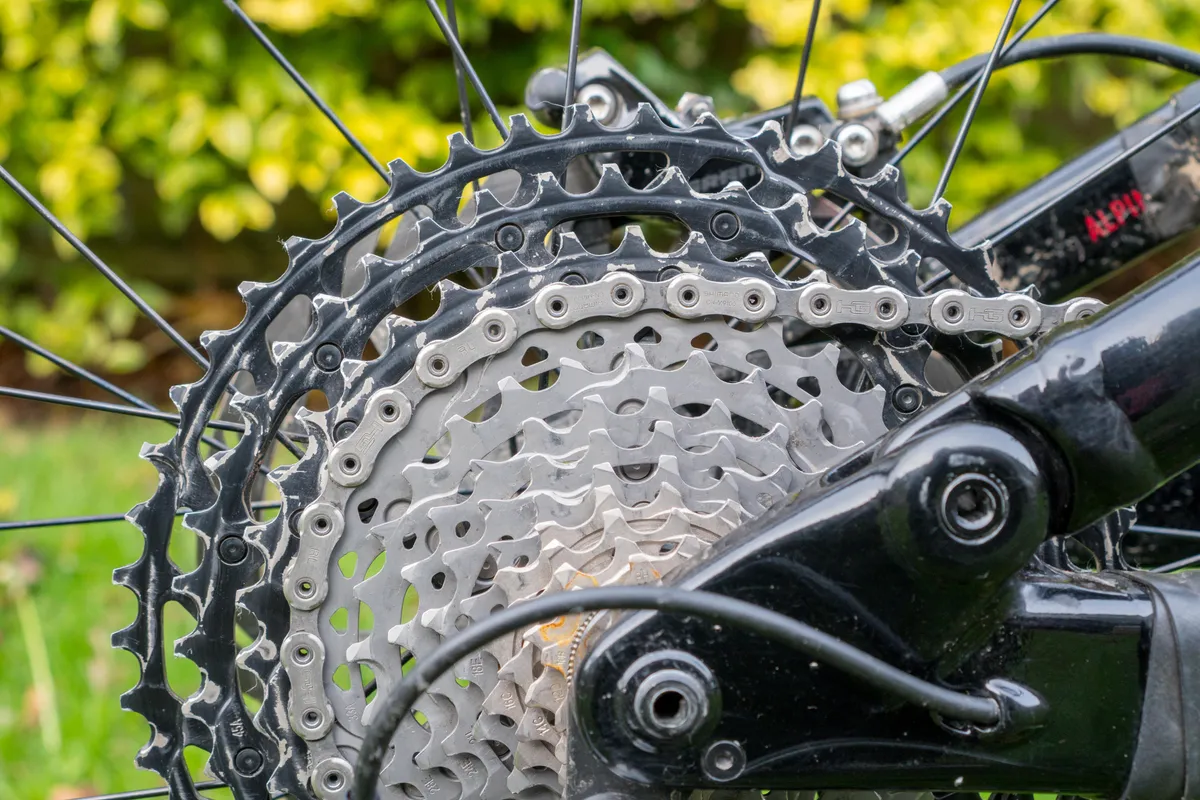
Arguably the jewel in the XTR crown, the XTR CS-M9100 cassette builds on the XT version’s steel and aluminium construction by adding five titanium sprockets to further reduce weight.
The three largest of its sprockets are made from aluminium, the next five are titanium and the smallest four are made from steel. The titanium and aluminium sprockets are fastened to an aluminium spider using pins.
The XTR cassette is available in 10-45t and 10-51t 12-speed options, with the 10-51t having the following sprocket sizes: 10t, 12t, 14t, 16t, 18t, 21t, 24t, 28t, 33t, 39t, 45t, and 51t.
It uses Shimano’s Micro Spline freehub standard and is based around Hyperglide+ technology, working best with other Hyperglide+ products.
The XTR CS-M9100 (10-51t) cassette weighed 374g on my scales.
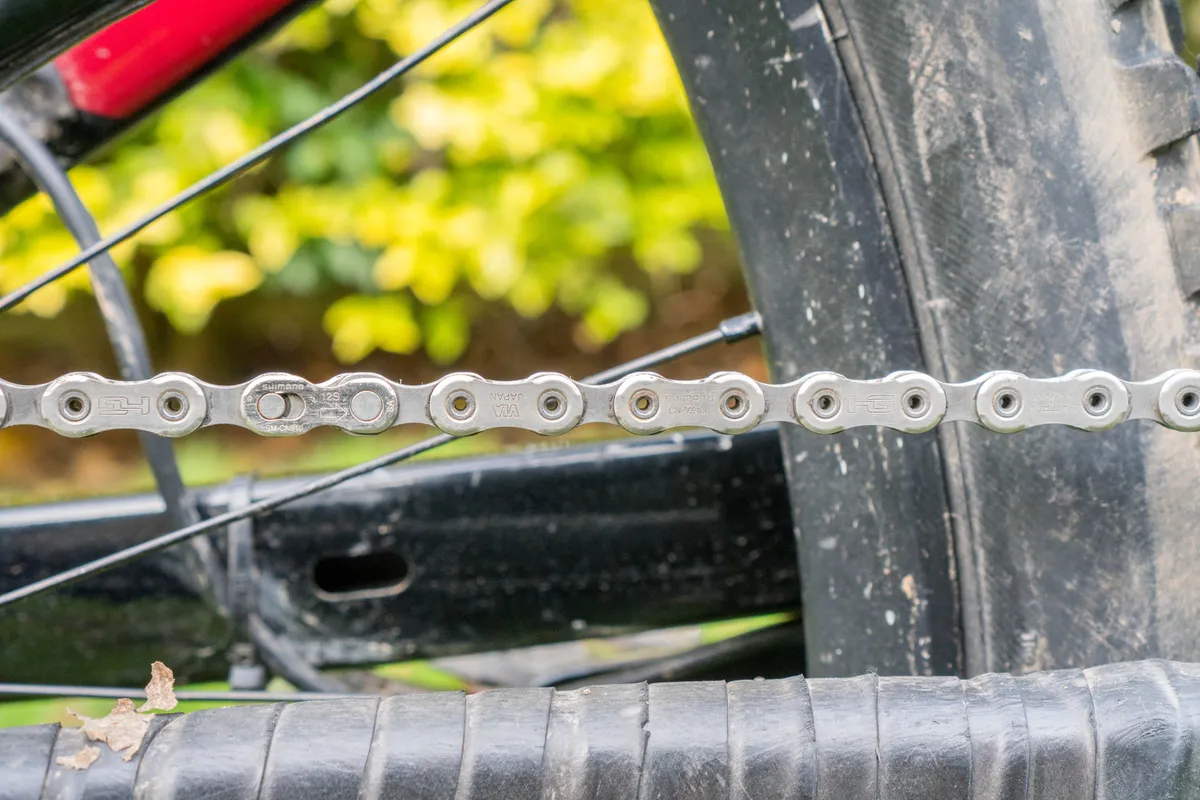
Best paired with the high-tech XTR CN-M9100 chain, it has an extended inner plate to aid with chain retention, a part of the Hyperglide+ tech.
It’s coated with Sil-Tec, Shimano’s ultra-low-friction surface treatment. This uses carbon molecules coated in fluorine to create a repellent but stable-enough-to-stick-to-the-chain formula that is claimed to improve system performance, run smoother and wear much slower than non-coated chains.
According to Shimano, friction is reduced by 60 per cent, mud-shedding performance is improved by 30 per cent, and wear and abrasion resistance improved by 20 per cent.
To boot, it has hollow pins, is quick-link compatible, and has chromizing roller link plates to decrease corrosion.
The XTR CN-9100 116 link chain with quick link weighed 249g on my scales.
Shimano XTR M9100 groupset compatibility
Although the XTR M9100 groupset should work best as a full-house of components, and you’ll reap the weight-saving benefits, any one of its parts is also compatible with any other 12-speed Shimano components. That’s great news for people who like to pick and choose where they want to spend their money.
Like the rest of the Shimano 12-speed cassettes, your rear hub will need a Micro Spline freehub driver for a Shimano cassette to work.
Third-party and aftermarket components will work with the XTR M9100 kit, but might decrease performance in some scenarios. Shimano doesn’t officially sanction the use of third-party components with its drivetrains.
Shimano XTR M9100 groupset installation and setup
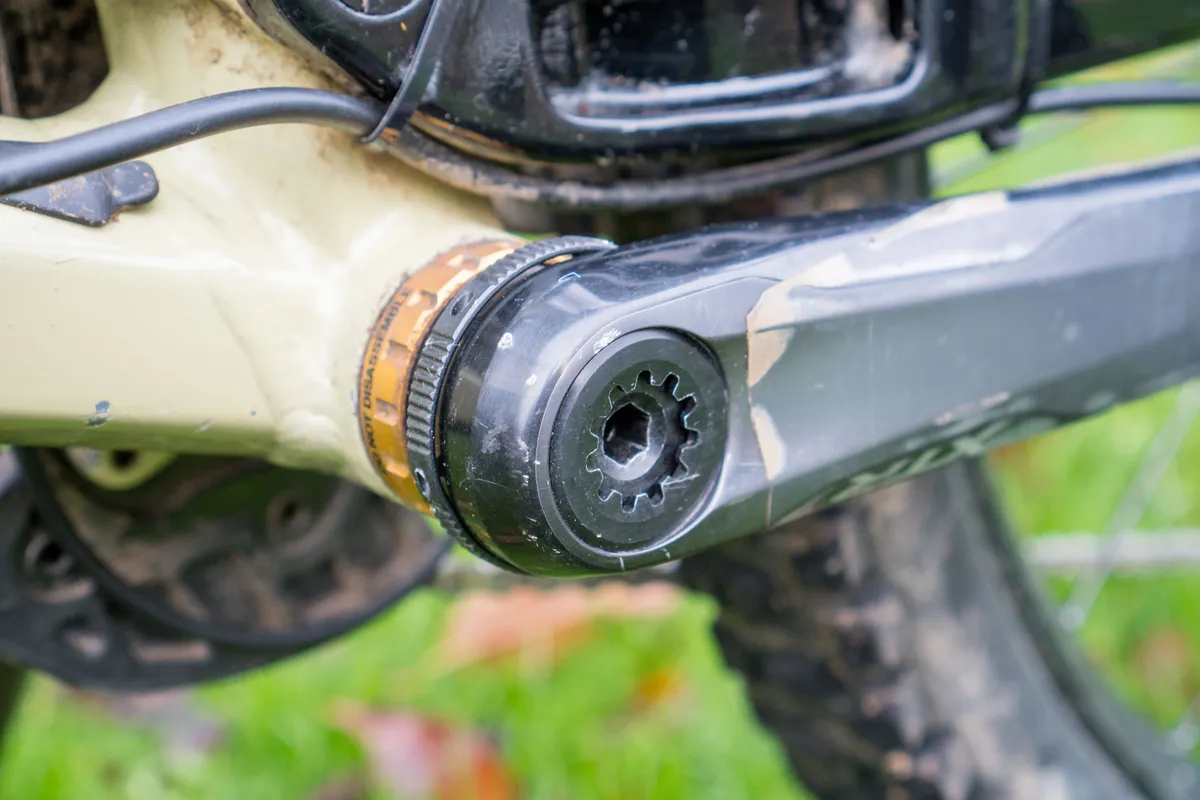
Unlike the rest of Shimano’s 12-speed cranksets, the XTR FC-M9120-1 uses a non-driveside preload ring (akin to SRAM’s DUB system) to generate the necessary bearing preload.
First, the non-drive crank is tightened to the bottom bracket axle using the 8mm Allen bolt, then further tension is wound on using the preload ring. The ring is turned and tightened using a small 2mm Allen key.
At first, the system appears flimsy considering the ring is made from plastic, but it proved to be fool-proof to set up and robust during testing. Unlike the SRAM DUB system preload rings that have a habit of loosening off during riding, the Shimano version didn’t suffer the same fate.
Care needs to be taken to make sure the correct number of axle spacers are installed, and that they are installed in the correct orientation to provide correct bearing sealing.
Installation and removal of the chainring required the same tool (TL-FC41) as the rest of Shimano’s cranksets, and this was supplied in the retail packaging with the cranks.
The chain needs to be installed in the correct orientation, where the stamped XTR logo must face outwards, and the quick link must be installed with its arrow pointing in the direction of the chain’s travel.
The chain’s length must be set to Shimano’s specifications to ensure the correct operation of the derailleur.
Failure to follow the instructions could lead to a decrease in performance.
Installation of the derailleur, cassette and shifter was straightforward, and was identical to the rest of Shimano’s 12-speed kit.
Setting the derailleur’s b-tension was another key factor in getting optimal performance. The marker on the back of the derailleur’s cage – that made the process easy, especially compared to SRAM’s b-tension adjustment method – needs to line up with the cassette’s lowest point when the derailleur is in the largest sprocket.
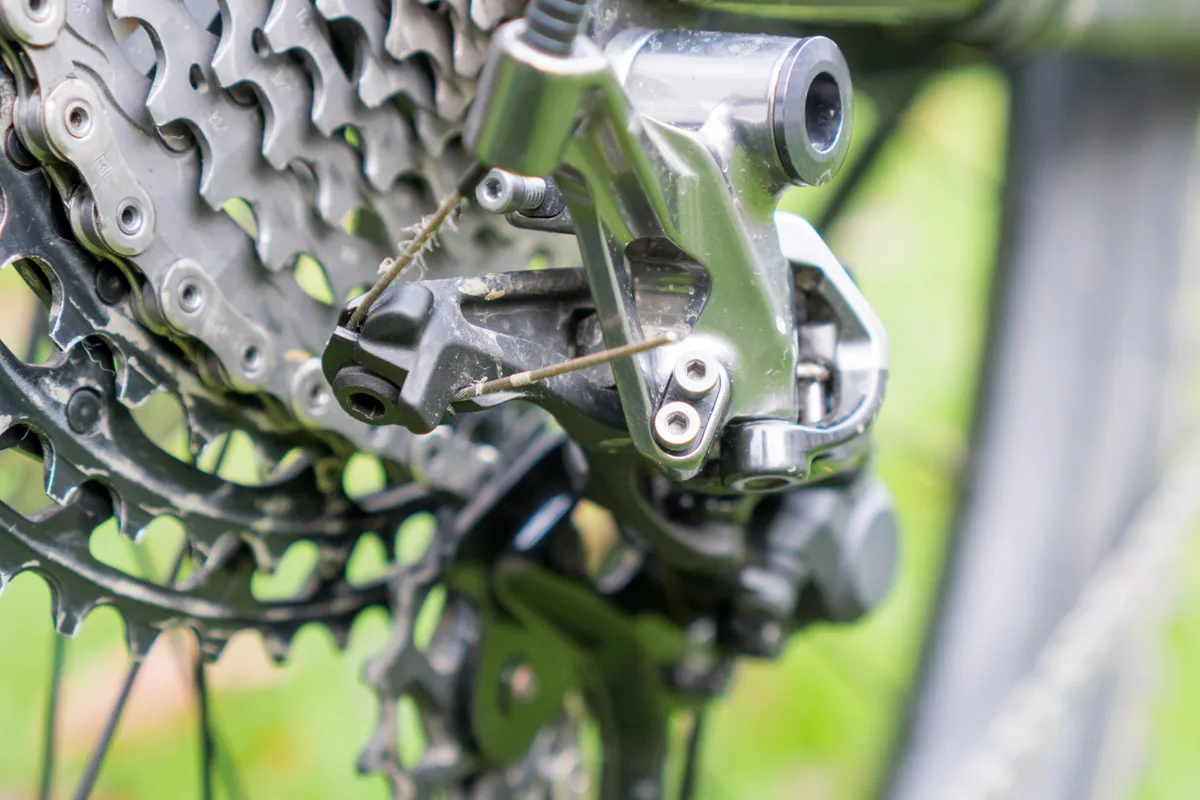
Adjusting the high- and low-gear limit screws was also simple, but all the adjusters have a 2mm Allen key head, which can be easy to round out. This problem is shared across all 12-speed Shimano derailleurs.
Cable tension needed to be finger tight, and the 160-degree cable wrap-around clamp made tensioning it easy.
Shimano XTR M9100 groupset performance
I tested Shimano’s XTR M9100 groupset over the course of eight months, when I managed to accumulate just over 1,100km of off-road riding. The drivetrain was initially installed on my Yeti SB165 long-term test bike, and then later got fitted to my Marin Alpine Trail XR.
Because of the prolonged nature of the test period, conditions ranged from the wet and cold at the end of winter through to blistering-hot summer days, and then a soggy but mild autumn and varying early winter.
Thanks to the scope of the test, the drivetrain has been subjected to the widest range of mud, slop, dust, rocks, loam and every condition in between.
The testing in Scotland’s Tweed Valley, home to the UK’s round of the Enduro World Series, ranged from super-gnarly, rough and bumpy DH trails and the tracks the EWS used in 2021’s competition, to man-made trail centre loops.
The drivetrain has undergone a thorough test.
Shimano XTR RD-M9100-SGS rear derailleur performance
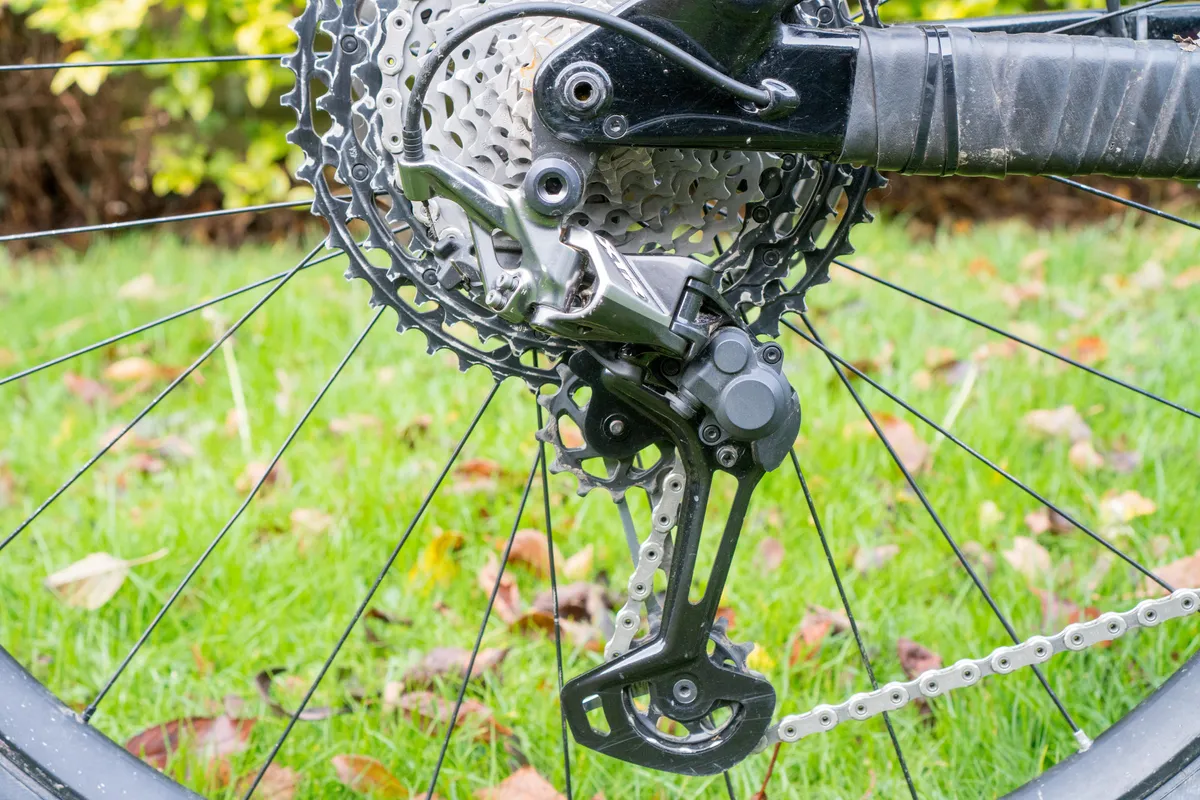
Given the derailleur’s light weight, it was remarkably robust during the test period. It resisted multiple knocks and bashes during the time it was fitted to my enduro bike and remained twist and bend free.
However, that was only true for the second derailleur I fitted to the bike. The first XTR RD-M9100 lasted only a handful of rides before the carbon fibre cage outer plate on the lowest point split in half.
Although this didn’t affect performance in the short term, and I continued to use the bike with the broken derailleur, it was a bit of a concern given the high purchase cost of the derailleur.
I spoke to Shimano about the failure, but they couldn’t definitively determine its cause. However, the cage had hit a rock, root, or other hard object while I was riding, causing it to get damaged. Both inner and outer parts of the cage on an XTR derailleur are replaceable, costing £9.99 / €12.99 and £89.99 / €99.99 respectively.
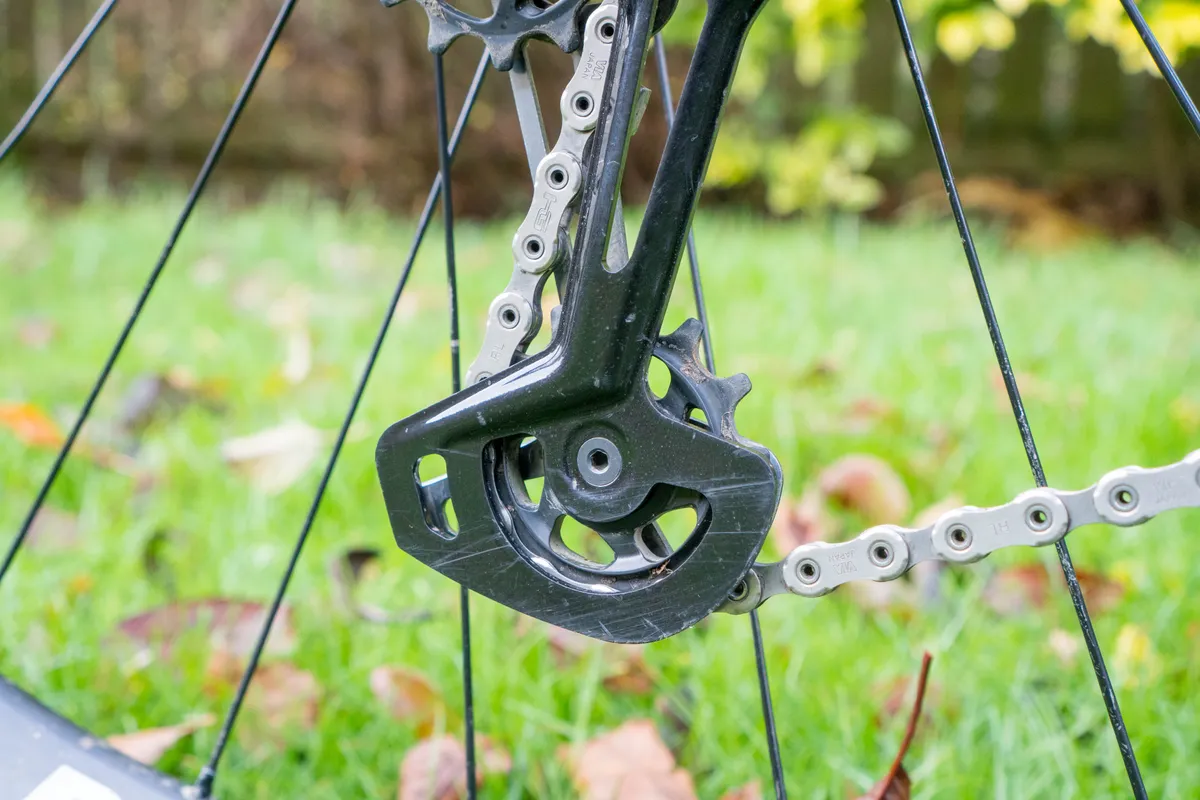
The cage on the second derailleur I fitted to the bike remains undamaged to this day, despite bearing the signs of a hard life, with scratches and pockmarks on its lower portion. This suggests the damage caused to the cage on the first derailleur was unusual rather than indicative of an underlying manufacturing weakness.
The clutch’s stock setting wasn’t quite strong enough to totally neutralise chain slap, but it is easy to adjust and has a wide range of adjustment. I tightened the clutch by a full turn to reduce noise, although more adjustment remained. Once set like this, it controlled the lower portion of the chain impeccably. This increase in clutch tension didn’t cause any stiff shifting, either.
Shifting under power was hugely impressive, too. The derailleur didn’t transfer any of the strain it was under through the cable and into the shifter lever, and it didn’t clunk, sneeze or jump into gears while shifting on the pedals.
Changing gears remained precise and crisp-feeling with no deterioration during the test period. That was despite the cage developing a small amount of flex between it and the derailleur's main knuckle. This flex wasn’t because the cage had come loose, or even that there was play, but appeared to be caused by everything flexing.
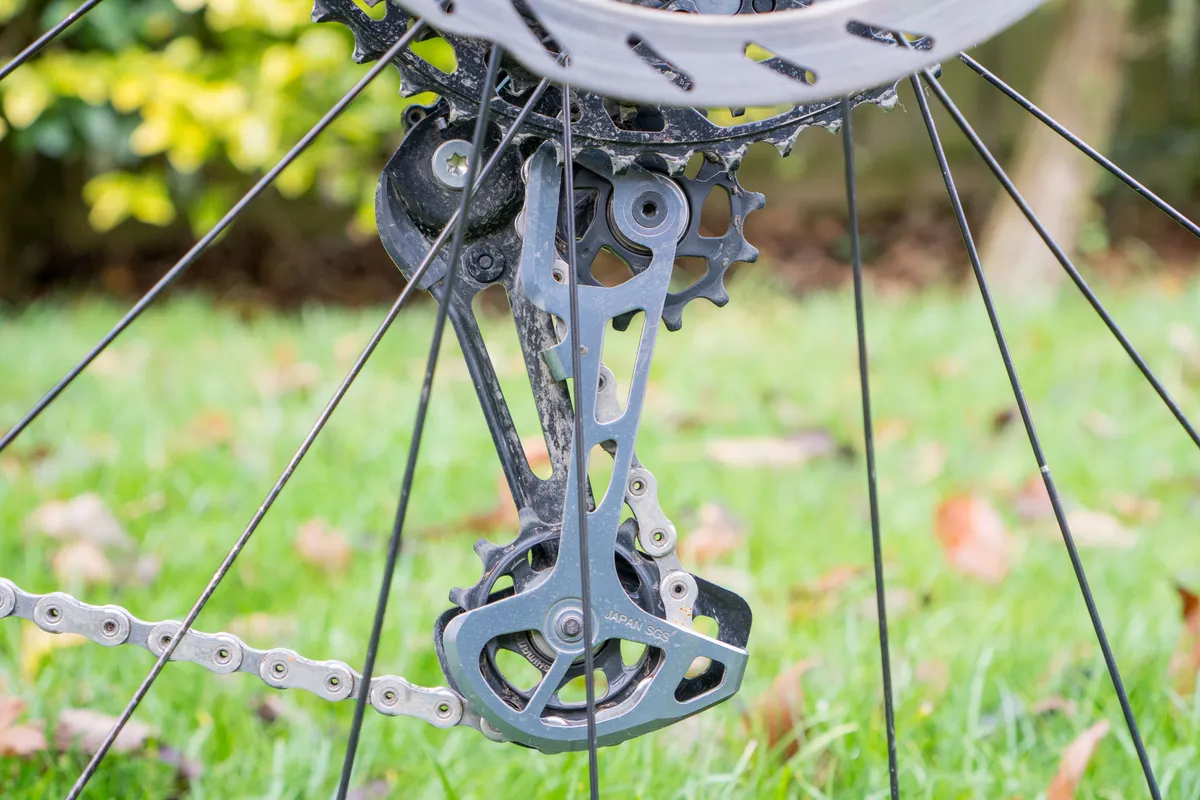
From time to time, the derailleur sneezed or ghost shifted both up and down the cassette from the selected gear. The terrain type or gear selected appeared to have no effect on when this happened. No number of cable or b-tension adjustments seemed to cure the irregular jumping, and it could happen once on a ride or once in a month’s riding.
The only explanation I have is that as the suspension compressed, the shortening of the chain and subsequent tightening of the cage, combined with the chain line, caused the derailleur to be pulled momentarily across the cassette. As the suspension extended, everything returned to normal. In theory, this could be related to the small amount of cage flex I discussed previously.
Overall, however, the derailleur’s performance and robustness were impressive given its light weight, but then it is expensive.
Shimano XTR SL-M9100-R shifter performance
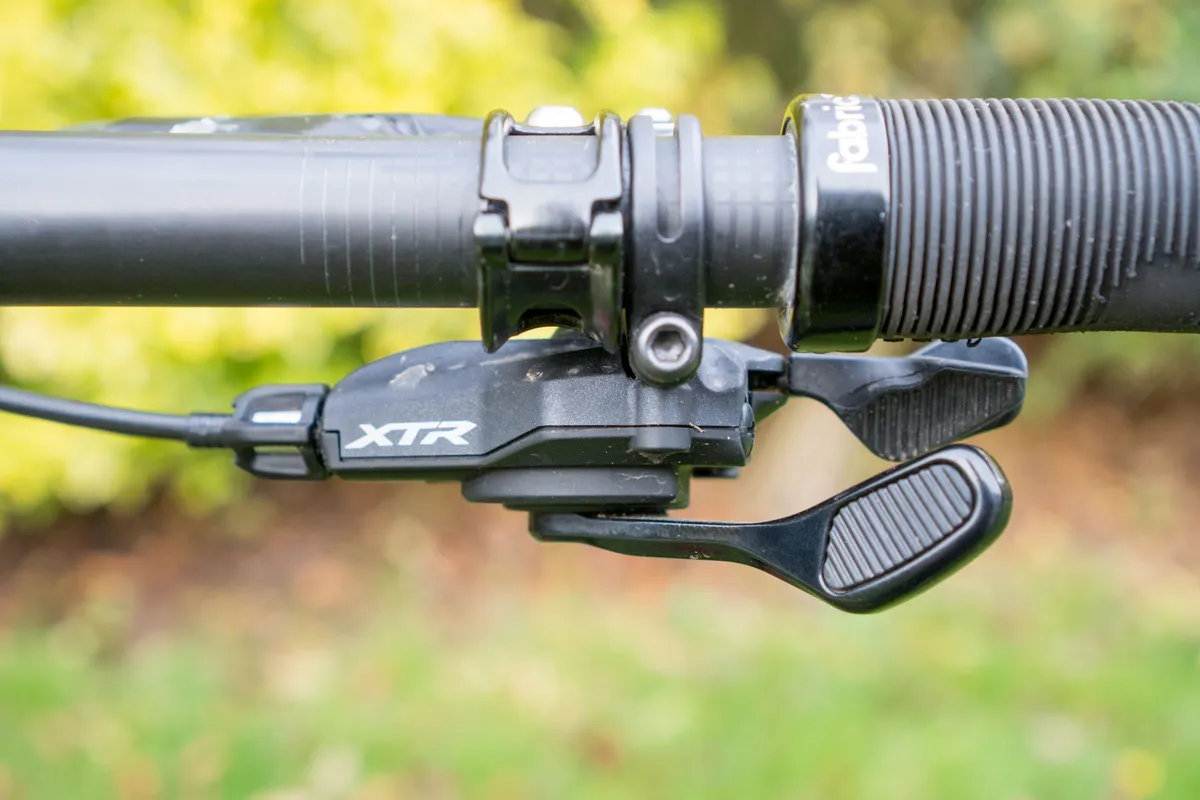
Shift feel is second to none. Both the high- and low-gear selector levers have a short throw and incredibly crisp and defined feel as each gear is selected. Shifts are incredibly light regardless of whether the drivetrain is under power or not.
The paddles are excellently shaped (and virtually identical to the rest of Shimano’s MTB 12-speed shifters), striking a good compromise for being long enough so they are easy to reach, but not so long that they get in the way. They’re textured and offered ample grip in wet conditions, or if my hands became sweaty.
The slim profile of the shifter’s clamp made it easy to position for my preferences because it didn’t take up much space on the bars. This expands the shifter’s compatibility with brakes from brands that don’t have I-SPEC EV compatibility.
Sealing was impressive. Over the course of the test period, I didn’t have to change the inner or outer cables, or clean the internals of the shifter because it had become rusty or clogged with mud or dust.
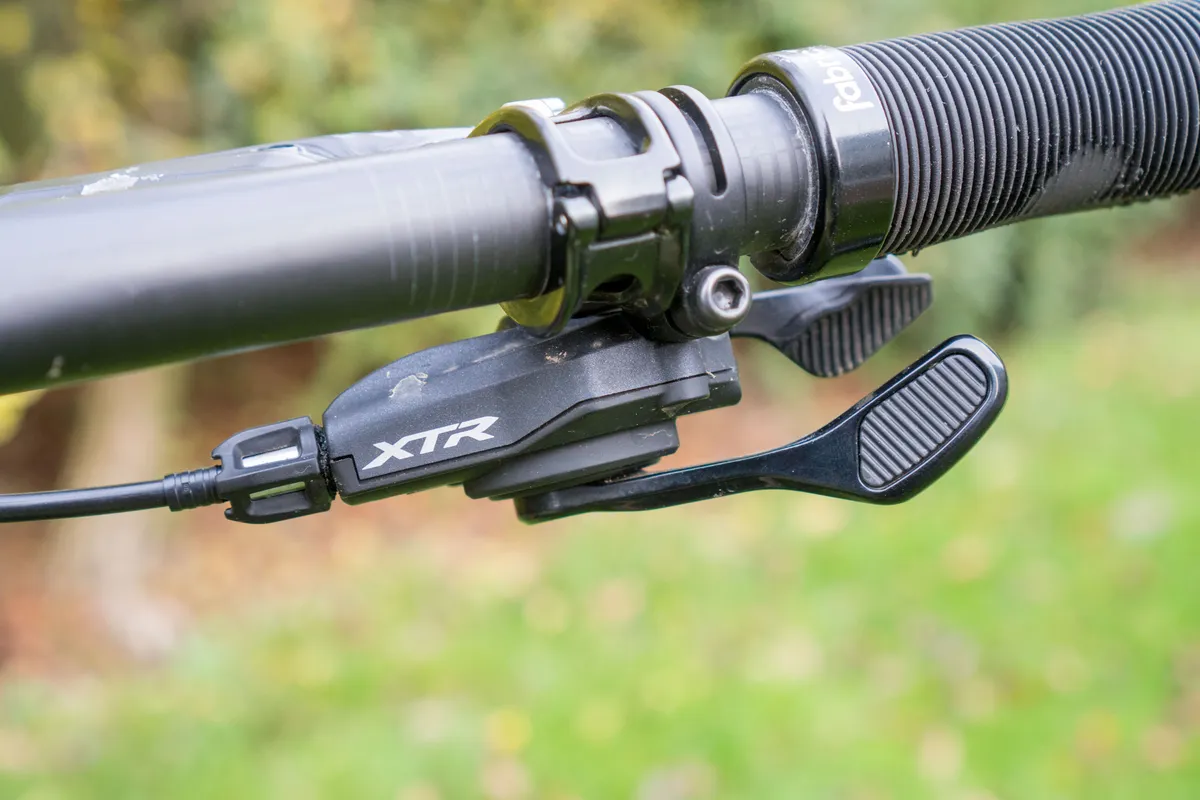
The Multi Release and Rapid Fire Plus technologies improved performance and shifting speed where I frequently found myself shifting up and down the cassette in blocks of gears rather than one cog at a time.
The XTR shifter is a true masterpiece, and is one of the groupset’s defining components, both in how its operation is ergonomically impressive, but also the premium feel it gives to each shift.
Shimano XTR CS-M9100 (10-51t) cassette and Shimano XTR CN-M9100 (116-link) chain performance
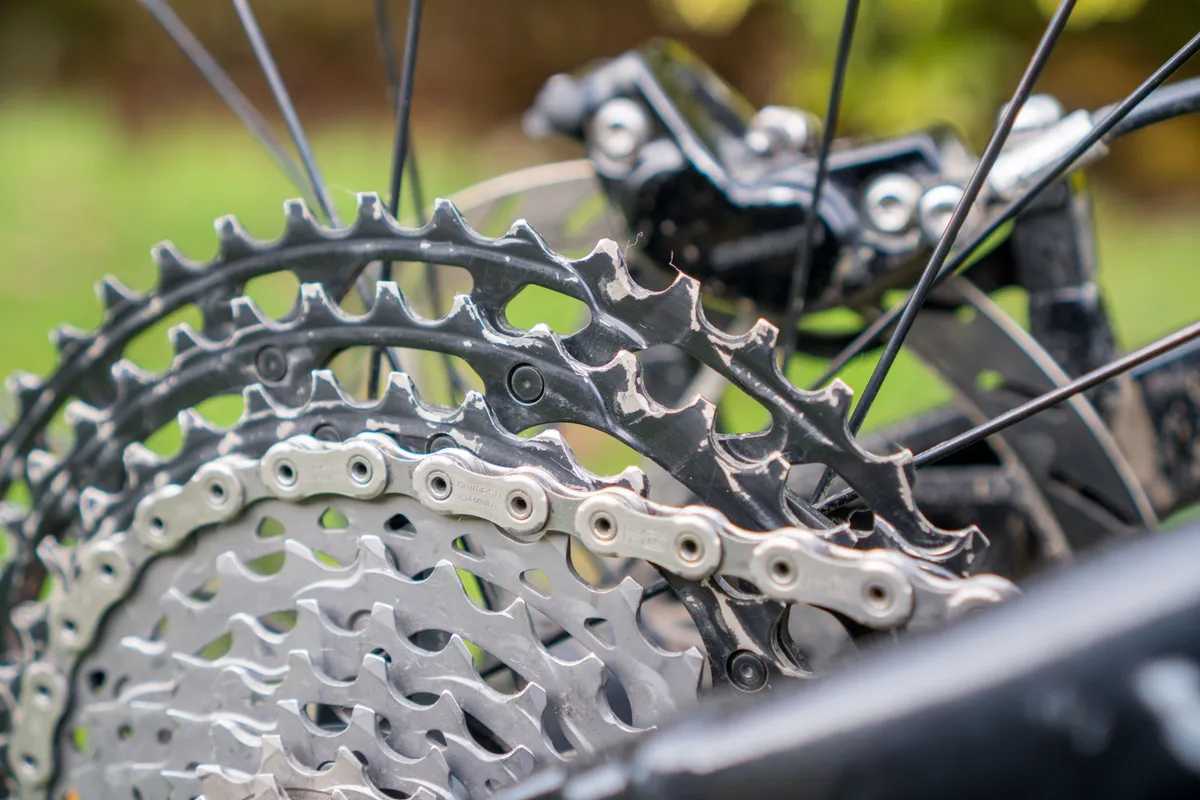
As with the rest of Shimano’s 10-51t cassettes, the spacing between each of the sprockets feels highly considered, with no one gear too much of a jump from the next. This is especially noted on the largest cogs, where none of the jumps between gears exceed six teeth. This is significantly lower than the largest 10-tooth jump on SRAM’s 12-speed 10-52t cassettes.
Although the easiest Shimano sprocket is one tooth short of SRAM’s offering, this can be compensated for with a smaller chainring, and I personally preferred using Shimano’s cassette with a 30t chainring, rather than the more commonly fitted 32t.
Given the cassette's remarkably low weight, it has proven to be one of the most robust out there. Even after over 1,000km of truly hard riding, the teeth on the aluminium and titanium portions of the block are showing no signs of hooking or excessive wear, where only the coating on the aluminium sprockets has started to degrade as the chain has been shifting between gears.
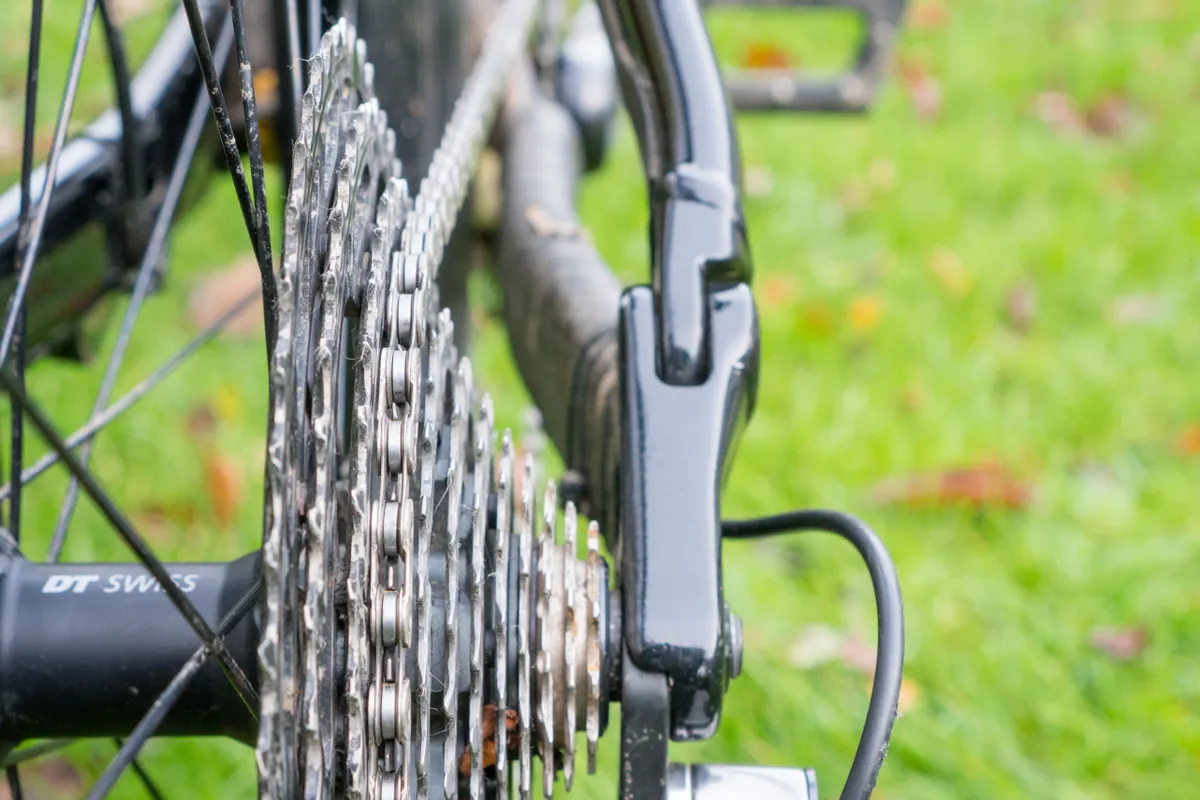
My only complaint is that when gears nine, eight or seven are selected, there is an irregular creaking and clicking noise. Although it’s hard to pinpoint the exact cause of the creaking, because it only happens in these gears infrequently – which corresponds to the titanium sprockets – I suspect there could be a small amount of flex or movement where those sprockets are pinned to the spider.
Arguably, though, it’s the weight savings and associated reduction of rotating and un-sprung mass that make the XTR CS-M9100 most appealing, and it tips the scales 99g lighter than the XT CS-M8100 cassette.
Unlike the Shimano XT M8100 and Shimano Deore M6100 chains I've tested, the XTR one has proved faultless during the test period, not getting damaged, snapping or showing significant signs of wear.
Shimano XTR FC-M9120-1 crankset with 30t chainring performance
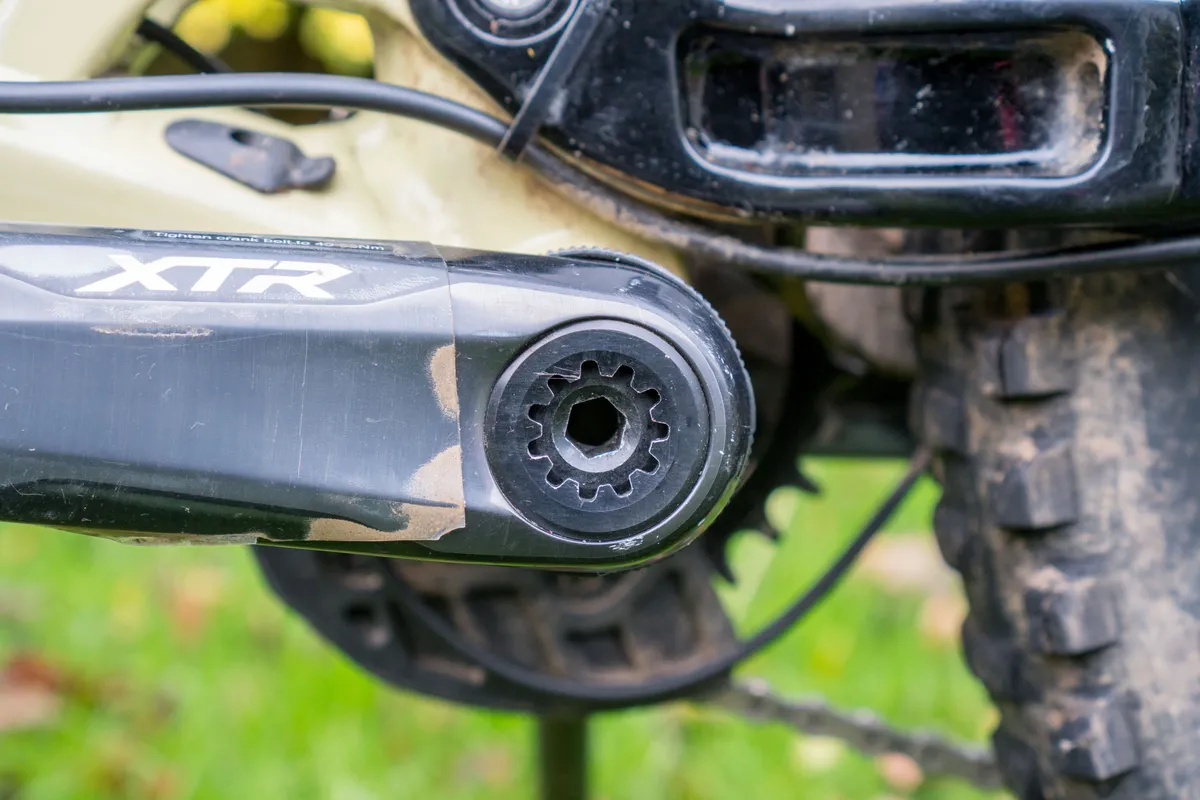
The XTR crankset has proven to be one of the most robust I’ve ever used. Testimony to their strength-to-weight ratio, I have bent two pedal axles on separate occasions while testing the cranks. In both instances, the pedal contacted a tree stump, stopping the bike dead, and subsequently bent. The cranks remained straight and true and are still showing no signs of damage.
Because of their evident strength, I couldn’t perceive any flex while pedalling.
Cosmetically, they’ve fared well and have brushed off rock strikes well. However, their anodised finish has rubbed off where my foot contacts the cranks while pedalling or descending. I attempted to protect them with 3M tape, but this also wore through.
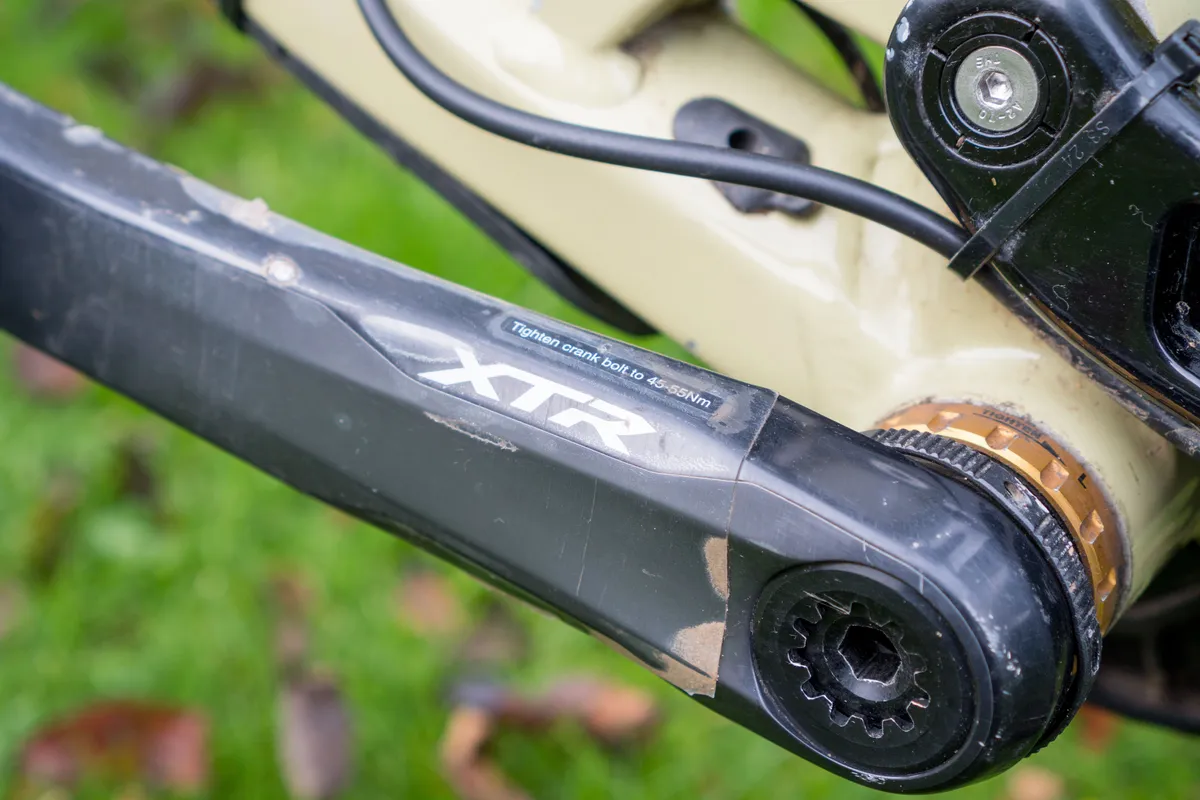
A polished-silver finish would be a good option for people who rub cranks with their feet and would maintain the premium feel for longer.
The ultra-lightweight chainring has fared well too. Its teeth have remained hook- and damage-free for the duration of the test period, and I have not once dropped a chain.
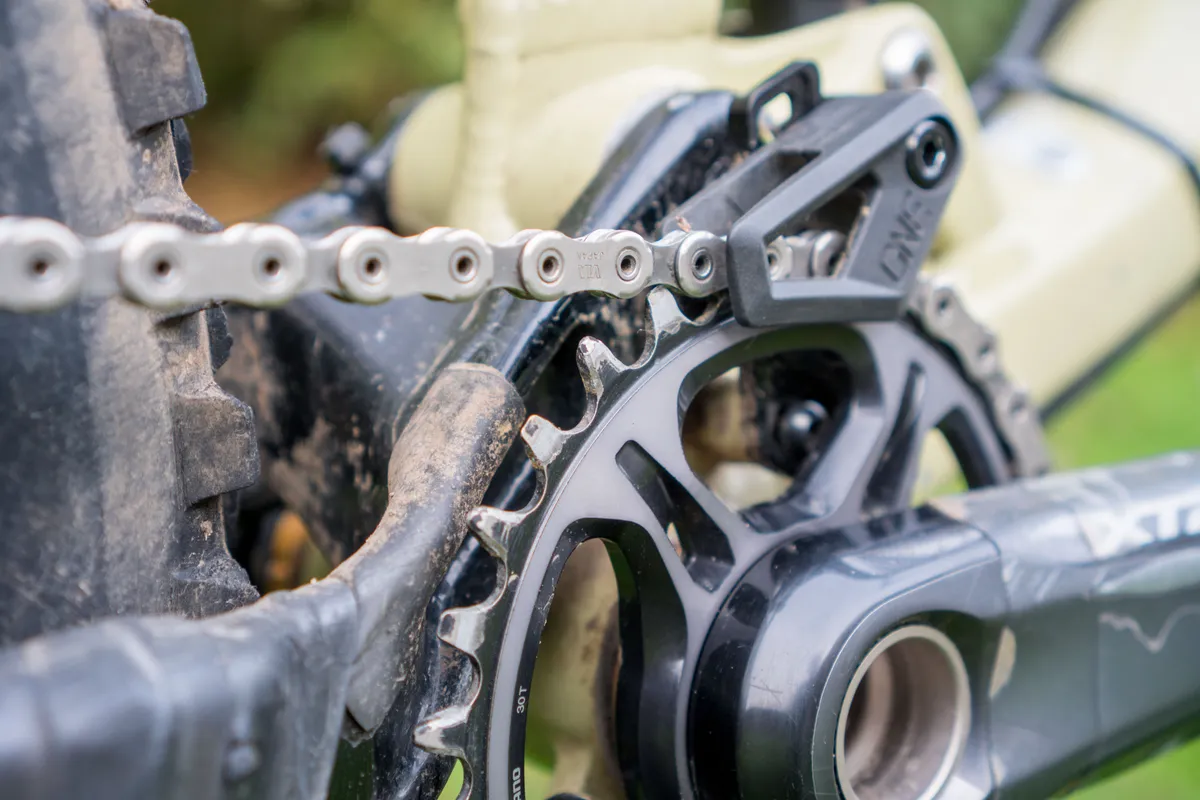
Its ability to cling onto the chain, even when it’s covered in mud, is impressive, and it didn’t hook onto the bottom of the chainring.
It ran quietly, too, but general operation benefited greatly from a fastidious maintenance and lubrication schedule.
How does the Shimano XTR M9100 groupset compare to SRAM’s XX1 Eagle AXS and Shimano’s XT M8100?
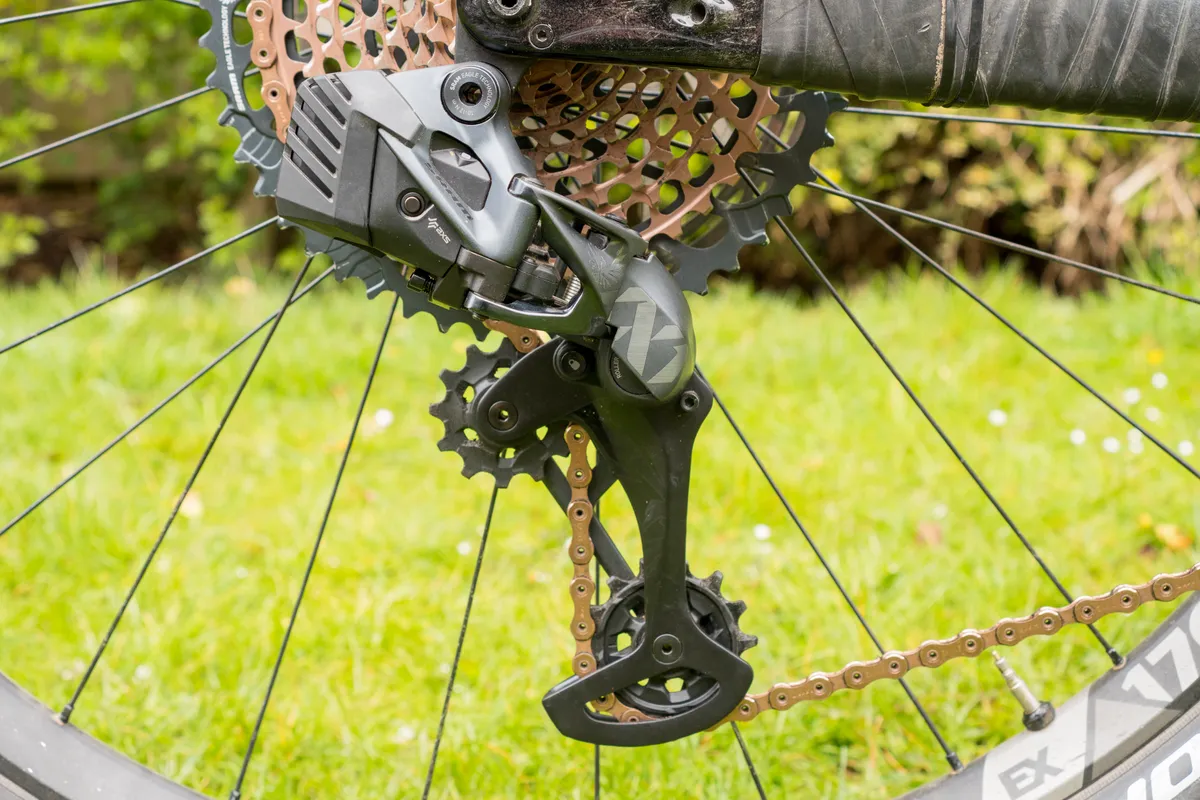
Although XTR M9100 isn’t electronically controlled like SRAM’s XX1 Eagle AXS, both are their respective brands’ halo 12-speed offerings (Shimano’s Di2 M9050 11-speed drivetrain still exits on Shimano’s website but doesn’t appear to be available to purchase from retailers), so a like-for-like comparison is fair.
XTR M9100 is cheaper at £1,125.94 / $1,469.94 / AU$2,134, compared to £1,958 / $1,949 / AU$2,783 for SRAM’s XX1 Eagle AXS. Neither represent fantastic value for money, however, but their weight and performance will appeal to certain people.
From a weight perspective, SRAM’s XX1 Eagle AXS weighs marginally less at 1,533g (with a 126-link chain and 32t chainring), compared to XTR M9100’s 1,543g weight (with a 116-link chain and 30t chainring). If weight is your main objective, opting for the XX1 groupset would be sensible.
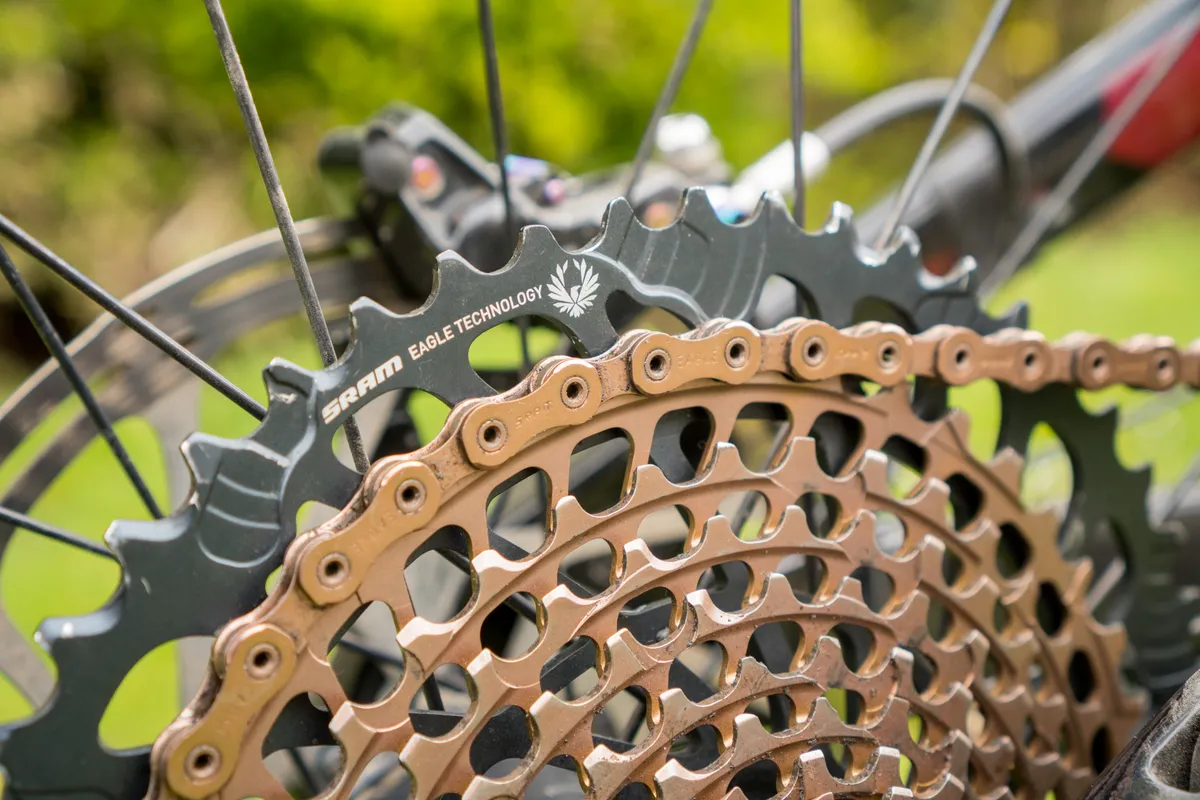
Break down the weights of the individual components, and it’s the shifter, chainring (30t) and cranks that push the overall weight of XTR over SRAM’s top-of-the-line drivetrain. The XTR derailleur, cassette and chain are all lighter than SRAM’s XX1, however.
From a performance perspective, comparing the two systems reveals each has flaws.
XX1 Eagle AXS’s shifting is seriously reliable and consistent no matter the conditions, but it lacks the smoothness of the on-power shifts of XTR. XTR, however, suffered from the occasional sneeze. When it was working as it should, each shift was remarkably crisp, plus on-power gear changes were smooth and made less noise than the SRAM system.
The XTR lever feel was well disconnected from the strains the derailleur was under, in a similar way to the wireless, electronic shifting of XX1.
Longevity of performance favours XX1, simply because it doesn’t have any cables that can deteriorate over time. Although the sealing on the XTR shifter and cable set was impressive, and they lasted much longer than I was expecting, they will eventually need changing.
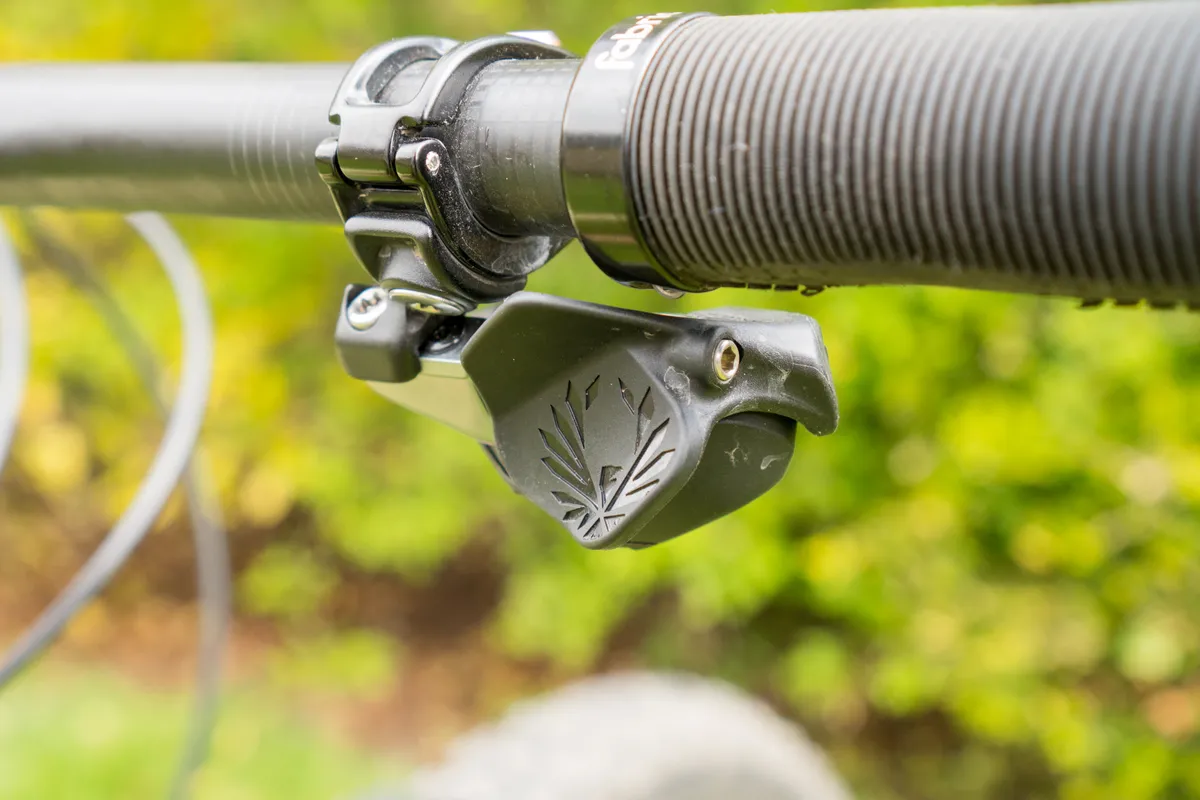
The adjustability of the Shimano clutch marks a significant difference between the two derailleurs. I found the un-adjustable clutch tension on the XX1 derailleur not sufficient to control the chain as well as I was expecting.
XTR doesn’t suffer from this problem, and should chain control be a major consideration, the choice to make between the two systems is much clearer, favouring Shimano.
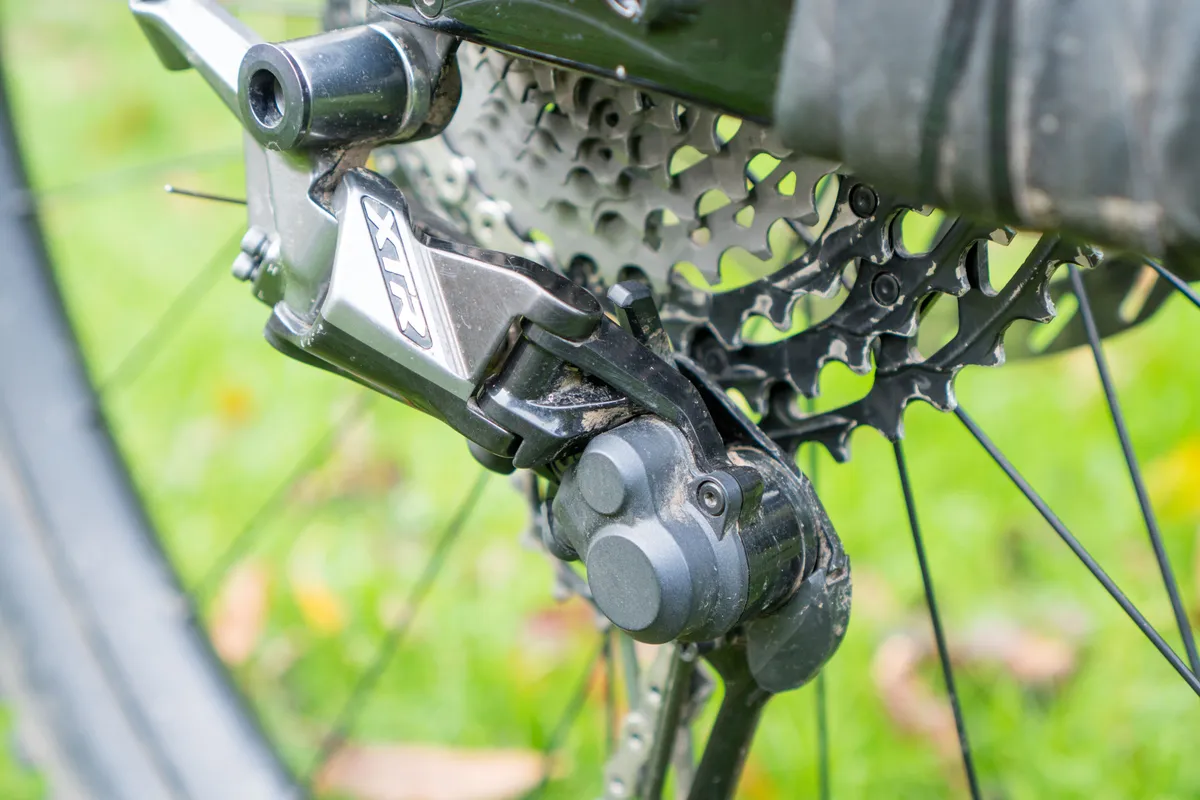
I personally prefer the gear ratios on the Shimano cassette, thanks to the gaps between the largest sprockets, but this might not be a problem for everyone.
Deciding which groupset is the outright winner is virtually impossible, but the £832.06 difference between the two might help, given XTR’s performance is – overall – no different to XX1, and they’re very close on weights too.
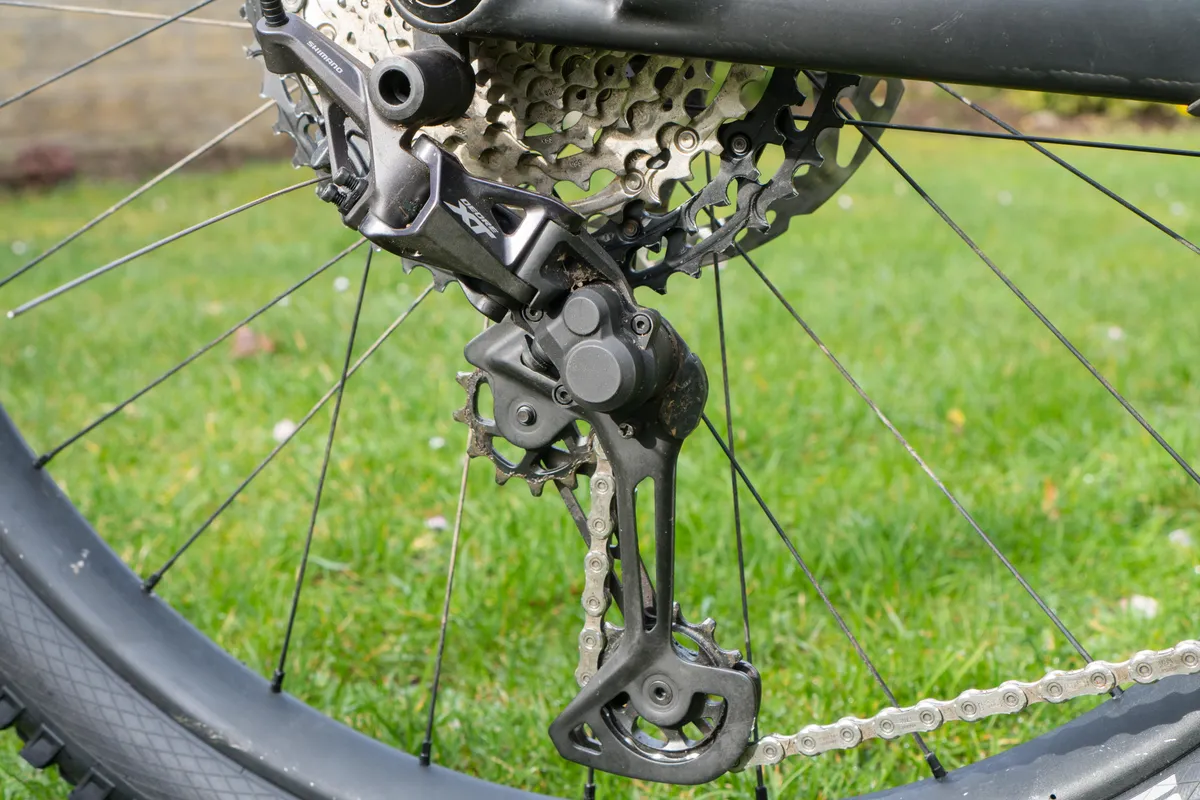
Compared to Shimano XT M8100, there’s little improvement, if any, in terms of performance for XTR M9100. It’s lighter (276g), but costs more (£559). Arguably, it looks better, the XTR chain is more durable and the lighter cassette could improve the performance of your rear suspension.
The perfect mountain bike drivetrain setup
If I was trying to create the ultimate performer for the lightest weight and most sensible cost, I would mix and match SRAM and Shimano parts.
I’d fit the XT M8100 derailleur because it didn’t suffer from the random flex-based ghost shifting, then fit the XTR M9100 chain, cassette and shifter, and finally bolt on a pair of SRAM XX1 cranks with an aftermarket 30t Shimano HG+ compatible chainring such as Wolf Tooth’s Elliptical chainring.
This setup would cost £1,083.96, weigh 1,489g – lighter and cheaper than both a full XTR M9100 or SRAM XX1 Eagle AXS setup – and offer, in my opinion, the best balance of performance, price and weight.
Shimano XTR M9100 groupset bottom line
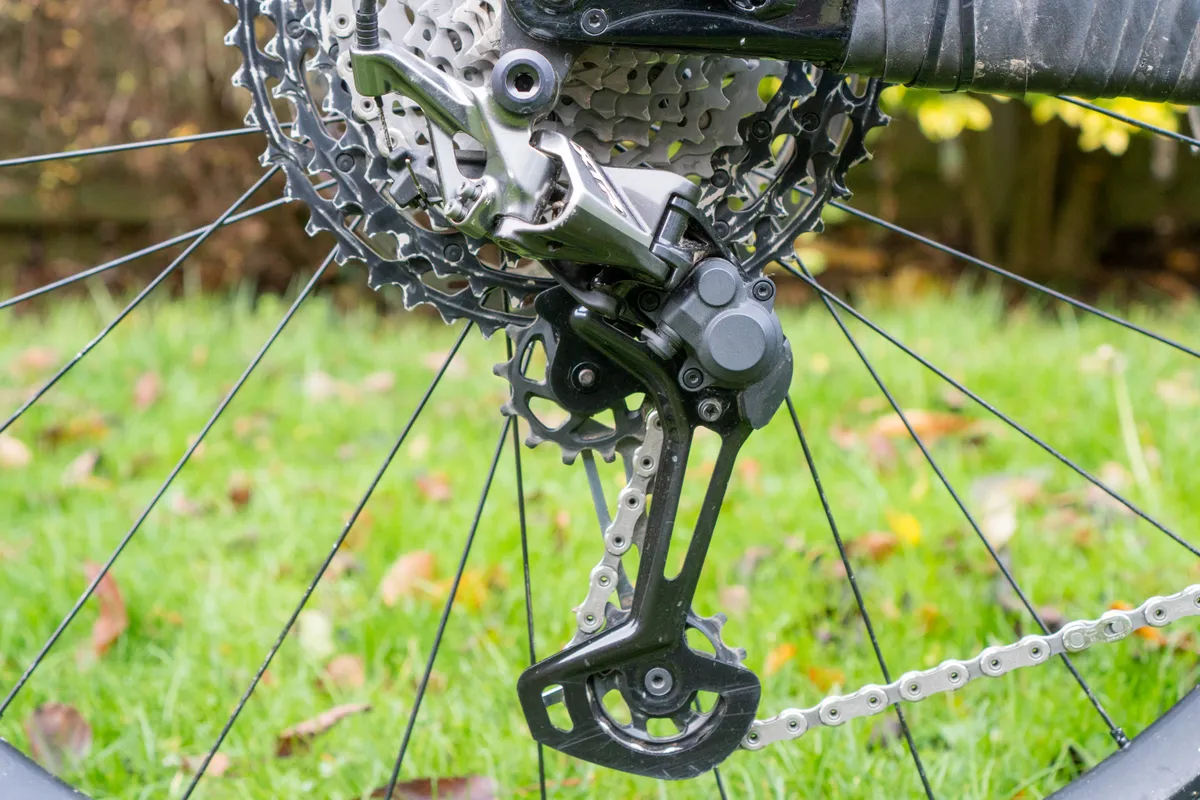
XTR M9100 is mighty in every respect, from price to performance.
It’s impressively light and is significantly more robust than its headline weight figure would suggest, making it capable of handling enduro-style riding rather than just the weight-conscious domain of cross-country.
It’s not perfect though. An intermittently sneezing derailleur and a creaky cassette were my biggest gripes, but the adjustable clutch and on-power shifting edge it ever so marginally ahead of SRAM’s XX1 Eagle AXS drivetrain in terms of performance.
I asked myself the question ‘would I buy this groupset?’ in the XX1 review, and answered with a resounding ‘no’. Posing the same question for XTR, I would answer in the same way.
Unless weight and bling are your thing, XTR doesn’t offer any significant improvements over XT (except for chain strength), and it costs double. That makes it hard to recommend.
The caveat to this, now that testing is complete, is that XTR is still fitted to my bike. Maybe I’m a secret magpie, but it speaks volumes when a technical editor at a bike review website chooses to fit a product to their personal bike to ride in their free time.
If it was my cash I was spending, I’d go for the SRAMano/ShimRAM mix I touched on above, but if you’re looking for a slightly more budget-conscious way – at least compared to XX1 Eagle AXS – to save weight and get top-level performance, XTR M9100 should be at the top of your list.
Product
| Brand | shimano |
| Price | 2134.00 AUD,1125.94 GBP,1469.94 USD |
| Weight | 1543.0000, GRAM () - Total weight including 170mm cranks with 30t chainring, rear derailleur, 116 link chain, 10-51t cassette and shifter |
| br_whatWeTested | Shimano XTR M9100 |
Features
| br_crankOptions | 1x |
| br_speed | 12 |
| br_cassetteOptions | 10-45t, 10-51 |
| br_chainringOptions | 30t, 32t, 34t, 36t, 38t |
